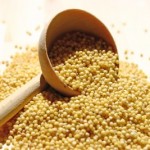 I don’t know what it is about millet, but whenever I make it I want to add fruit to it. Perhaps it’s the color, texture, or unique flavor, or perhaps some combination of the three.
I don’t know what it is about millet, but whenever I make it I want to add fruit to it. Perhaps it’s the color, texture, or unique flavor, or perhaps some combination of the three.
Millet is usually classified as an “alternative grain” — even though in reality millet is a seed, not a grain.
The millet seeds are teeny tiny in size, somewhat round and come in a variety of colors: white, gray, red, and yellow.
The Benefits of Millet
What makes millet such a great food choice is it is:
- Alkalizing, not acid-forming
- Gluten-free
Millet is a good source of:
- Manganese
- Tryptophan
- Magnesium
- Phosphorus
Millet provides around 20% of the daily value of all of these nutrients, some a little more, some a little less.
How do these nutrients benefit your health?
Manganese, a trace mineral which many of us don’t get enough of, facilitates the formation of many things in the body, including the bones, connective tissue, and sex hormones. Manganese is also needed for the proper functioning of the brain and nerves. It lends its hand in metabolizing two of the macronutrients (fat and carbohydrates), absorbing calcium, regulating blood sugar, and fighting free radicals.
Tryptophan, an essential amino acid, meaning one must obtain it from the diet, is key in controlling the appetite, alleviating or avoiding depression, and contributes to getting a good night’ sleep. Who doesn’t need that?
Magnesium, an essential major mineral, meaning it must be obtained from the diet and is needed in larger amounts, is responsible for creating and delivering energy to the body, producing protein, enzyme function, and contracting as well relaxing the muscles.
Phosphorus, also an essential major mineral, is well known for its role in forming strong teeth and bones.
What you may not know is phosphorus has a role in producing protein and ATP, a molecule needed to store energy. Phosphorus also works along with the B vitamins, facilitates the body’s use of fats and carbohydrates, helps the kidneys work properly, keeps our heartbeat regular, works with magnesium to contract our muscles, and is involved in nerve function.
A Millet Recipe
Ok, back to the millet and fruit!
I have created a couple of different dishes which were inspired by this seed. I am familiar with and really like the yellow variety of millet.
The first dish I call:
My Beta-Carotene Creation
- I cook one cup of millet at a one to three ratio (grain: water) in my rice cooker.
- While the millet is cooking I peel a large sweet potato and thinly slice it, throwing it in my steamer along with some cut up baby carrots.
- I steam the potatoes and carrots until tender.
- Next, I squeeze a couple of oranges for some delicious juice; grab a handful or two of organic raisins, and add everything to the cooked millet.
- Make sure when you add the juice to the millet it is moist, but not mushy!
A nice variation of this dish involves just adding the juice and raisins, along with some pineapple.
Add in mandarin oranges if you like, too.
Enjoy!